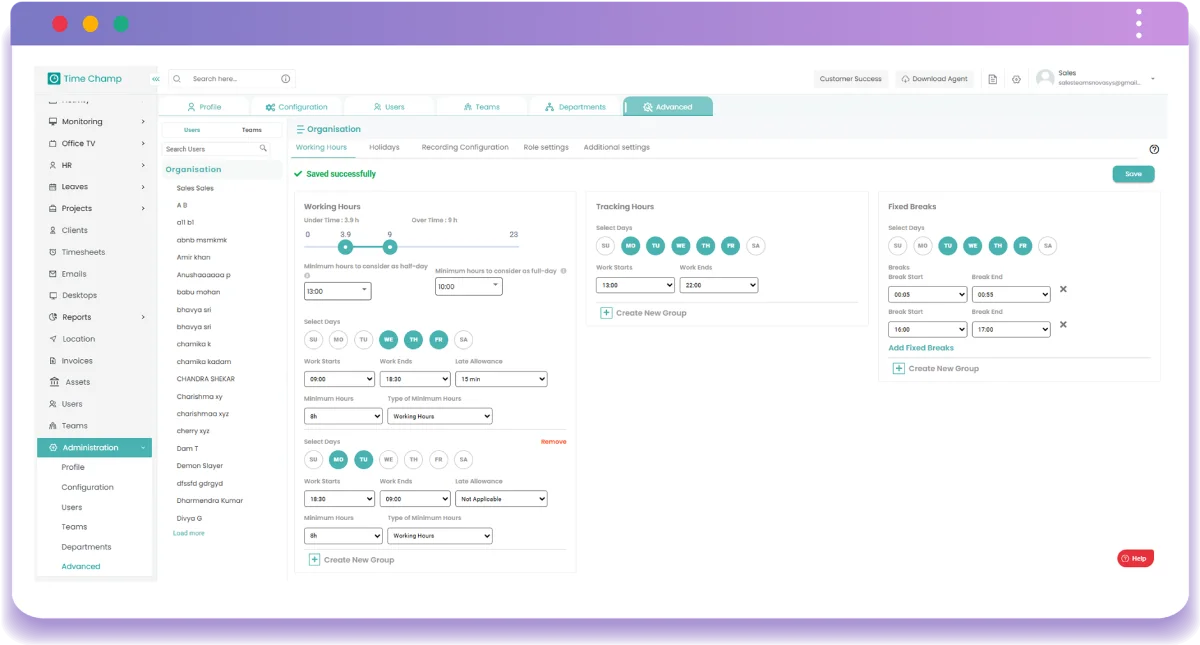What is Shift Roaster? Key Components, Benefits & Types
A shift roster, also referred to as a shift/work schedule or work roster, is an organized attempt to detail when each employee is scheduled to work for a designated period. Shift rotas are often used in 24/7 industries such as healthcare, business process outsourcing , manufacturing, and retail. The goal of a shift roster is to ensure all positions are filled correctly and should match up so that staff are not overworked or unfilled, while also not dumping work onto one another. The shift roster will contain employee names, the shift that they will be assigned, i.e., morning, evening, night, days off, and any special instructions. The defined work hours specify work to employees, and as such, a roster gets work done without confusion and helps organize the workforce with a view to tight coordination.
A well-structured shift roster improves operational consistency and helps to increase an employee's level of satisfaction because of transparency and work-life balance . The common types of shift rosters are fixed shifts, rotating shifts, split shifts, and on-call shifts that serve a variety of business and staffing needs. The key elements of a shift roster are employee availability, workload/ work hours , labour laws, and predicted employee work demand from the business. When implemented in the proper way, a shift roster involves reducing absenteeism, preventing burnout , enhancing productivity, and having an organized and accountable workplace.
What is a Shift Roster?
A shift roster is a plan that shows which worker will be working at what time on what day. It allows companies to manage their employees by arranging their working hours in a simple and structured way. For example, in a company that works 24/7, some workers will work mornings, some will work evenings, and some will work nights; we come to this shift plan using a shift roster.
A shift roster's primary function is to ensure that there will always be sufficient workers present at the appropriate times without anyone being overloaded. It also assists employees in discovering their working times ahead of time to better plan their personal lives. If a shift roster is done correctly, then work will run smoothly according to the shifts and there will be minimal confusion or missed shifts.
What Are the Key Components of Shift Roster?
A shift roster is simply a list of names and shifts, but it is a tool to aid scheduling and managing staff. If a roster is to fulfil its purpose, it must have a few fundamentals included. These components track who is working and when and where: it will simply list when each staff member is working, to schedule adequately who should be present, or who should do what during each shift. An effective shift roster improves the coordination of your team by eliminating confusion and ensuring operations are consistent.
Here are the 5 main components of a shift roster:
- Employee Names – Lists all the workers scheduled for shifts.
- Shift Timings –Shows the start and end times for each shift.
- Workdays and Days Off – Indicates which days employees are working or resting.
- Job Roles/Assignments – Specifies what task or duty each person will handle.
- Shift Rotation (if needed) –Displays how shifts will rotate over days or weeks.
What Are the Different Types of Shift Rosters?
Shift rosters can take a number of forms depending on the type of work, number of employees, and the business. Each type of shift roster manages working hours differently and aims to ensure the business operation runs smoothly and that work hours are shared fairly amongst employees. Having a good understanding of these types of shift rosters can lead to a better decision about which schedule is appropriate for your business and your employees.
Below are the most common types of shift rosters:
-
Fixed Shift Roster
Employees work the same shift at the same time every day (i.e., they always work the morning shift). This promotes standardisation and predictable routines.
-
Rotating Shift Roster
Employees work on a predetermined rotation of shifts, morning, evening, and night, that typically lasts one week or a month. This type of rotating shift roster aims to ensure the workload is shared fairly between employees and limits the potential for burnout.
-
Split Shift Roster
An employee works a shift, or work hours, that have been divided into two separates time blocks during the day (i.e., 9 am-1 pm and 5 pm-9 pm).
-
On-Call Shift Roster
Staff can select or change their work schedules based on their availability and the needs of their job. This approach supports a healthier work-life balance and increases employee satisfaction.
-
Adaptable Work Schedules
Staff members can choose or adjust their work schedules, contingent on their availability and the requirements of their role. This strategy supports a better work-life balance and boosts employee satisfaction.
Each option has advantages and disadvantages. The best choice depends on the company's goals, industry, and size of the team.
How to Use a Shift Work Roster Template?

A shift roster template is a quick and simple tool for ensuring the management of employee shifts and keeping a team working smoothly. You start with a template, and put in your specific information - the days, the shift times, and the names of employees. You can do staggered shifts (morning, day, or night) as required for your business hours.
Once you have put this structure together, you can then add in the shifts with the employees that will fit into each time slot you created by the days and take their availability and preferences into consideration to make it as balanced, reasonable, and feasible as you can for your business. Best practice is to send out the roster early, to allow all staff time to understand their shifts, to plan accordingly.
Ultimately, it is a good idea to have the roster set up so you can record updated rosters onto an existing template or one drafted in your favourite online tool, as shifts and staff can change quickly. This will help everyone be aware quickly, to avoid confusion, and reduce conflicts from late changes. Shifts are easier to manage for both leaders and team members.
With Time Champ, creating and managing shift rosters becomes even easier. The platform lets you build schedules, update changes instantly, and share them with your team in real time, ensuring everyone stays informed and aligned. Book your demo today and see how Time Champ simplifies workforce scheduling. Time Champ Product Demo|Time champ come upon thefull extent of Time champ features, from time tracking and payroll to support for multiple integrations.
What Are the Benefits of Using a Shift Roster?
- A shift roster allows employees to have more options to organize or swap shifts, helping them to juggle work and life, which usually produces increased job satisfaction and lowered turnover.
- Having a shift roster also allows employers to allocate work more evenly, reducing burnout in the workforce and ensuring there are always enough staff members available at peak times, which helps overall productivity and day-to-day operations be more consistent.
- Using a shift roster can also help control labour costs by reducing overtime and limiting overstaffing. When employers can schedule the right number of employees at the right times, operations work more profitably.
- Effective scheduling helps employees know when they are working well ahead of time, thus increasing attendance rates and minimizing unscheduled and last-minute absences.
- Rotating shifts can also create a well-rounded employee by giving employees the experience of working at different times and being exposed to differing teams , which builds skills and adaptability.
What Are the Challenges in Managing Shift Rosters?
Managing shift rosters comes with a multitude of challenges. Scheduling is prone to mistakes, especially in manual systems! Mistakes such as shifting assignments can lead to double bookings or missed shifts. Finding the right number of staff for busy and quiet periods can be complicated; whether it is overstaffing or understaffing, businesses and employees suffer as it creates problems in operations.
Unexpected or last-minute changes are unavoidable and can stall or hold operations; unplanned absences can be disruptive. Miscommunicating someone's shift at a particular time can result in missed shifts, confusion, and feelings of ineffectiveness. Distributing shifts fairly is also not a simple task, as managers want to demonstrate an unbiased approach; unfair staffing practices can lead to reductions in employee morale and satisfaction.
Allowing employees to swap shifts without manager approval exposes the organization to replacing key roles with employees who are not able to do the work required or employees who are not available, and touches on compliance issues; employees are issuing family member swaps without notice. Tracking employee preferences, availability, and keeping up with laws and compliance procedures adds to the challenge of developing a shift schedule. Also, managers risk working too long on submitting or finalizing rostering duties, limiting their available time to do other important work.
Automated scheduling solutions can help managers manage these common scheduling concerns and help ensure their organization runs safely and appropriately.
What Are the Best Practices for Shift Roster Management?
A solid shift roster depends first on an understanding of both the business needs and individual employee needs. Look for peak hours or workloads, then build shifts accordingly to ensure enough coverage while avoiding over- or understaffing. Scheduling software will assist in this process by tracking employee availability, automating routine scheduling tasks, and quickly notifying staff about changes.
Make sure to communicate clearly and give as much notice as possible to employees. This allows them time to plan and adjust accordingly. Best practice is to seek feedback as well as encourage swap shifts within guidelines, which can help shape satisfaction and reduce conflicts as well. Make sure all staff have fair access to less-desired shifts, ask about personal commitments, and take their childcare/school routines into consideration accordingly.
Always regularly review and modify the roster in order to understand your legal obligations as well as to support the work-life balance of your staff. Monitor and reflect on your outcomes and solicit input for improvement in the scheduling process so that staff members and businesses have seamless scheduling operations.
What Is an Employee Roster Management System?

An employee roster management system is a software solution developed to note and manage employee shifts and how a workforce is allocated. With an employee roster management system, managers can schedule employee shifts and roster staff, while automatically taking into account employee availability, business requirements, and legal considerations.
An employee roster management system may provide features to monitor attendance, allow shift swaps, and notify employees when there are any changes to the schedule. This can assist in accommodating unexpected changes to a schedule easily and cut down on scheduling mistakes.
An employee roster management system can aid in consolidating rosters, increasing transparency, increasing communication, and potentially avoiding over- or understaffing, saving administration time, and helping staff be more organized and productive in the workplace.

